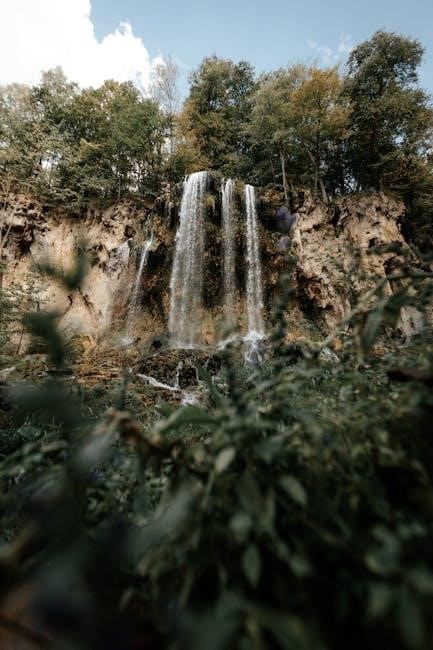Flashforge Guider II: A Comprehensive Overview
The Flashforge Guider II is an industrial-grade 3D printer designed for prosumers and hobbyists. It features robust construction, a large build volume, and compatibility with various filaments, making it a versatile choice for diverse printing needs.
The Flashforge Guider II stands out as a robust and reliable 3D printer, targeting both experienced hobbyists and professional users. It’s built with industrial-grade components, ensuring stability and longevity. The Guider II utilizes Fused Filament Fabrication (FFF) technology, a widely adopted method in 3D printing, allowing it to work with a range of materials like ABS, PLA, and specialty filaments. Its large build volume is a key feature, enabling users to create sizable prints or multiple smaller objects in a single run. The enclosed build chamber and heated bed contribute to consistent print quality by maintaining a stable environment.
Key Features and Benefits
The Flashforge Guider II boasts industrial-grade design, a large build volume, and broad material compatibility, including ABS, PLA, and specialty filaments. These features translate to robust performance and versatility for various applications.
Industrial-Grade Design and Robustness
The Flashforge Guider II distinguishes itself with an industrial-grade design focused on enhanced stability and durability. Constructed with a robust, fully enclosed structure, it ensures consistent print quality by maintaining a stable internal environment, shielding prints from external factors like drafts and temperature fluctuations. This ruggedness is essential for reliable performance in demanding environments. The Guider II’s sturdy build quality minimizes vibrations and enhances precision during printing, contributing to finer details and overall superior output. Its design caters to users who require a dependable 3D printer capable of handling extensive use and complex projects, making it a valuable asset.
Large Build Volume
The Flashforge Guider II boasts a substantial build volume of 280 x 250 x 300 mm (11.0 x 9.8 x 11.8 inches), providing ample space for creating larger models or printing multiple smaller parts simultaneously. This generous capacity empowers users to tackle ambitious projects without the constraints of a limited build area. The expanded volume is particularly advantageous for producing functional prototypes, custom parts, and intricate designs, catering to a wide range of applications from engineering to artistic creations. The extensive build area significantly enhances the printer’s versatility, making it an ideal choice for professionals and hobbyists alike seeking to maximize their creative potential.
Material Compatibility: ABS, PLA, and Specialty Filaments
The Flashforge Guider II offers broad material compatibility, supporting a wide range of filaments including ABS, PLA, and various specialty materials. This versatility allows users to experiment with different properties and achieve diverse printing results. ABS provides durability and heat resistance, while PLA offers ease of use and biodegradability. The Guider II can also handle specialty filaments like flexible TPU, PETG, wood-filled, metal-filled, and carbon fiber composites, enabling the creation of functional parts with unique characteristics. This extensive material support makes the Guider II suitable for diverse applications, from prototyping to creating end-use products with specific requirements. The ability to use various materials expands the printer’s capabilities and provides users with greater design freedom.

Technical Specifications
The Flashforge Guider II boasts a build volume of 280 x 250 x 300 mm, a layer resolution of 100-200 microns, and compatibility with a wide range of filaments. Its single extruder system ensures reliable printing.
Print Technology and Resolution
The Flashforge Guider II employs Fused Filament Fabrication (FFF) technology, a widely used method in 3D printing. This technology involves extruding thermoplastic filaments layer by layer to create a three-dimensional object based on a digital design. The Guider II achieves a layer resolution ranging from 100 to 200 microns, allowing for the creation of parts with fine details and smooth surfaces. This level of resolution is suitable for both functional prototypes and aesthetic models, catering to a diverse range of applications. The printer’s precision ensures accurate reproduction of intricate designs.
Extruder and Nozzle Details
The Flashforge Guider II is equipped with a single extruder, designed for reliable and consistent filament feeding. The standard nozzle diameter is 0.4mm, a common size that offers a good balance between print speed and detail. The extruder temperature can reach up to 240°C in the Guider II, allowing it to process a variety of materials. The Guider IIs, an upgraded version, can reach 300°C. This precise temperature control is crucial for achieving optimal results with different filament types, ensuring strong layer adhesion and minimizing warping.
Print Speed and Precision
The Flashforge Guider II offers a print speed of approximately 24cc/h, balancing speed and quality for detailed prints. Its precision is reflected in its layer resolution capabilities, ranging from 100 to 200 microns, enabling the creation of smooth surfaces and intricate designs. The Guider II achieves XY positioning precision of 11 microns and Z-axis precision of 2.5 microns, contributing to accurate and consistent prints. This level of precision ensures that even complex geometries are rendered faithfully, making it suitable for both functional prototypes and detailed models.

Guider II vs. Guider IIs
The Guider IIs is an upgraded version of the Guider II, featuring enhancements like an HD camera for remote monitoring and an air filtration system. These upgrades make the “s” model a more advanced option.
Key Differences and Upgrades in the IIS Model
The Flashforge Guider IIs distinguishes itself from the Guider II through several key enhancements. Notably, the Guider IIs boasts an improved extruder, facilitating the printing of flexible materials and high-temperature plastics, expanding the range of usable filaments. Another significant upgrade is the integrated HD camera, enabling remote online monitoring of the printing process. Furthermore, the Guider IIs incorporates an air filtration system, equipped with a HEPA filter and fan, designed to enhance safety and reduce unpleasant odors during printing. These upgrades position the Guider IIs as a more versatile and user-friendly option.
HD Camera for Remote Monitoring
The integration of an HD camera in the Flashforge Guider IIs represents a significant enhancement for users seeking remote oversight of their 3D printing endeavors. This built-in camera allows for real-time monitoring of the printing process from a distance, providing valuable insights into the progress and potential issues that may arise. Users can conveniently check on their prints via a connected device, ensuring timely intervention if necessary. The HD camera feature not only adds convenience but also contributes to a more efficient and controlled 3D printing workflow, especially for lengthy or critical projects.
Air Filtration System
The Flashforge Guider IIs incorporates an advanced air filtration system, a critical addition for users prioritizing a healthy and odor-free printing environment. This system utilizes a high-quality HEPA filter and fan to effectively reduce unpleasant odors and potentially harmful particles released during the 3D printing process. By actively filtering the air within the enclosed print chamber, the Guider IIs minimizes the risk of respiratory irritation and promotes a safer workspace. This feature is especially valuable when working with materials like ABS, which are known to emit stronger fumes. The air filtration system enhances user comfort.

User Experience and Reviews
Users praise the Flashforge Guider II for its print quality and reliability. It is considered easy to use for both beginners and professionals. Feedback highlights both pros and cons, offering balanced insight.
Print Quality and Reliability
The Flashforge Guider II is known for producing high-quality prints with consistent reliability. Users report successful outcomes across various materials, including ABS, PLA, and specialized filaments. The printer’s enclosed chamber helps maintain a stable printing environment, contributing to reduced warping and improved layer adhesion. Many users have noted minimal print failures, even during long print jobs, demonstrating its robustness. The Guider II consistently delivers accurate and detailed parts. Overall, user experiences suggest that the Guider II offers a good balance between print quality and reliable performance, making it suitable for various projects.
Ease of Use for Beginners and Professionals
The Flashforge Guider II aims to strike a balance in user-friendliness for both novice and experienced users. Its intuitive 5-inch color touchscreen interface simplifies navigation and control. Features like auto filament detection contribute to a seamless setup process. While beginners can quickly grasp the basics, professionals appreciate the advanced settings and customization options available for fine-tuning print parameters. The Guider II’s enclosed design and reliable performance reduce the learning curve for newcomers. With its straightforward operation and advanced capabilities, the Guider II is accessible to a wide range of users.
Pros and Cons Based on User Feedback
User reviews of the Flashforge Guider II highlight several advantages, including its robust build quality and large print volume. The ability to print with various materials is also frequently praised. However, some users have noted that the initial setup can be challenging, and the price point may be a deterrent for hobbyists. While print quality is generally high, occasional issues with adhesion and warping have been reported. The Guider II’s enclosed chamber helps mitigate these problems. Overall, user feedback suggests that the Guider II is a capable printer with a few minor drawbacks.
Applications and Use Cases
The Flashforge Guider II is suitable for creating prototypes, functional parts, and custom designs. Its material compatibility makes it useful across engineering, design, education, and hobbyist projects with high precision requirements.
Suitable for Hobbyists, Prosumers, and Education
The Flashforge Guider II caters to a diverse audience, from hobbyists exploring 3D printing to prosumers requiring reliable prototyping capabilities. Its ease of use and enclosed build chamber make it ideal for educational settings, allowing students to safely learn about additive manufacturing. The printer’s ability to handle various materials expands its utility across different disciplines, enabling users to create functional parts, artistic models, or educational tools. Its robust design ensures durability, making it a worthwhile investment for individuals and institutions seeking a versatile and dependable 3D printing solution that meets varying needs.
Examples of Projects and Materials Used
The Flashforge Guider II’s versatility shines through its wide range of project applications and material compatibility. Users have successfully printed functional prototypes using ABS for its durability and heat resistance. PLA, known for its ease of use and eco-friendliness, is often employed for creating intricate models and decorative items. Specialty filaments, like flexible TPU, allow for the production of parts with rubber-like qualities, such as gaskets and phone cases. Educational institutions utilize the Guider II to create demonstration models, replacement parts for equipment, and hands-on learning tools, showcasing the printer’s ability to meet diverse project requirements with a variety of materials.

Where to Buy and Pricing
The Flashforge Guider II can be purchased from online marketplaces like Amazon and directly from Flashforge’s website. Pricing varies, so comparing retailers is essential to find the best value.
Available Retailers and Online Marketplaces
The Flashforge Guider II enjoys availability across a spectrum of retailers and online marketplaces, catering to diverse purchasing preferences. Major online platforms such as Amazon and eBay frequently list the Guider II, offering competitive pricing and convenient shipping options. Specialty 3D printing equipment suppliers also stock the Guider II, providing expert advice and support; Direct purchases from Flashforge’s official website are another avenue, ensuring authenticity and access to the latest deals. Availability may vary depending on geographical location and current stock levels. Always verify retailer credibility before purchasing.
Price Comparison and Value Proposition
When evaluating the Flashforge Guider II, comparing prices across different retailers is essential. Prices can fluctuate based on promotions, vendor markups, and included accessories. The Guider II typically resides in the mid-range price bracket for industrial-grade 3D printers. Its value proposition lies in its robust build, large print volume, and material compatibility. Considering these features against competing models in a similar price range is crucial. Assessing user reviews regarding reliability and print quality further aids in determining whether the Guider II offers superior value for the investment.
